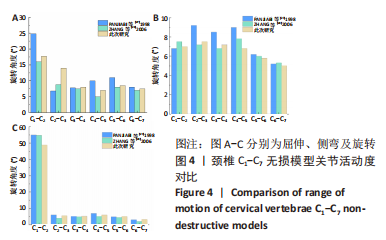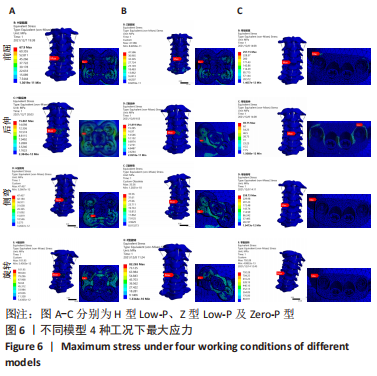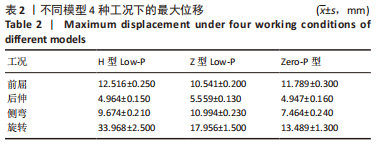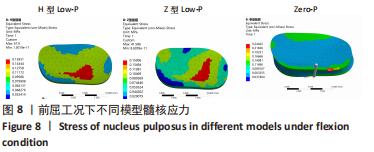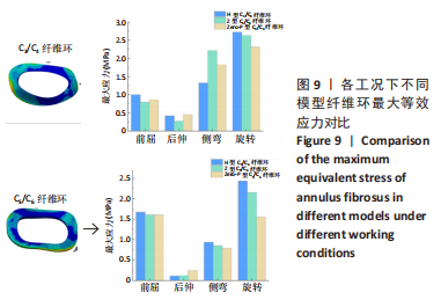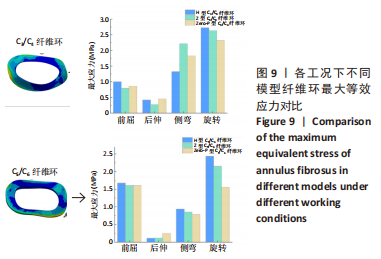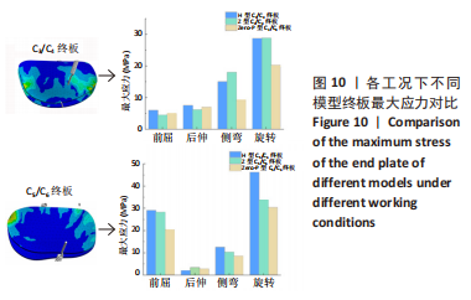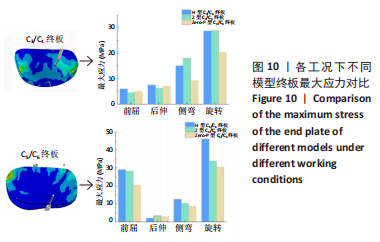Chinese Journal of Tissue Engineering Research ›› 2024, Vol. 28 ›› Issue (6): 821-826.doi: 10.12307/2023.787
Biomechanical changes of the cervical spine in internal fixation with different anterior cervical interbody fusion systems
Wang Qiang1, Li Shiyun1, Xiong Ying2, Li Tiantian3
- 1School of Mechanical and Electrical Engineering, Kunming University of Science and Technology, Kunming 650000, Yunnan Province, China; 2Department of Orthopedics, Yan’an Hospital, Kunming Medical University, Kunming 650051, Yunnan Province, China; 3Shanneng New Energy (Dongying) Co., Ltd., Dongying 257000, Shandong Province, China
-
Received:2022-11-01Accepted:2022-12-28Online:2024-02-28Published:2023-07-11 -
Contact:Li Shiyun, Professor, School of Mechanical and Electrical Engineering, Kunming University of Science and Technology, Kunming 650000, Yunnan Province, China -
About author:Wang Qiang, Master candidate, School of Mechanical and Electrical Engineering, Kunming University of Science and Technology, Kunming 650000, Yunnan Province, China -
Supported by:Major Science and Technology Special Project of Yunnan Provincial Department of Science and Technology, No. 202102AA310040 (to XY)
CLC Number:
Cite this article
Wang Qiang, Li Shiyun, Xiong Ying, Li Tiantian. Biomechanical changes of the cervical spine in internal fixation with different anterior cervical interbody fusion systems[J]. Chinese Journal of Tissue Engineering Research, 2024, 28(6): 821-826.
share this article
Add to citation manager EndNote|Reference Manager|ProCite|BibTeX|RefWorks

2.2 各种不同内固定模型ROM 通过对颈椎置入Zero-P系统、H型Low-P系统、Z型Low-P系统,比较3种不同内固定模型对颈椎的ROM影响。颈椎C1-C7节段在前屈、后伸、旋转、侧弯不同工况下的ROM值见图5所示。C4-C5各工况下ROM值表明,前屈工况下,H型Low-P系统、Z型Low-P系统置入后的ROM值比Zero-P系统增大41%;后伸工况下,H型Low-P系统、Z型Low-P系统置入后的ROM值比Zero-P系统增大107%;侧弯工况下,H型Low-P系统、Z型Low-P系统置入后的ROM值比Zero-P系统增大70%;旋转工况下,H型Low-P系统、Z型Low-P系统置入后的ROM值比Zero-P系统增大37%。推测新型Low-P系统可以改善术后ROM值。通过分析邻近节段C3-C4、C5-C6 ROM值,表明Zero-P系统的影响程度要大于新型Low-P系统。"
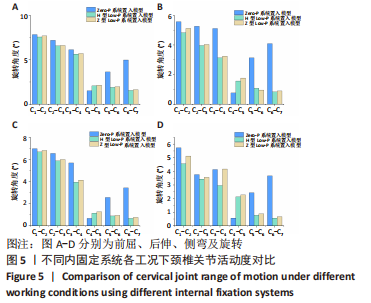
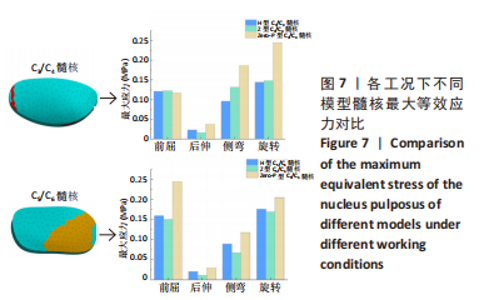
最大等效应力显示,Zero-P系统在不同工况下的最大应力均大于H型和Z型,其中前屈工况下,Zero-P系统的最大应力值为257.15 MPa,比H型增加了379%,比Z型增加了618%,且H型比Z型增加了63%;后伸工况下,Zero-P系统的最大应力值为69.75 MPa,比H型增加了339%,比Z型增加了219%,且Z型比H型增加了37%;侧弯工况下,Zero-P系统的最大应力值为258.73 MPa,比H型增加了545%,比Z型增加了727%,且H型比Z型增加了33%;旋转工况下,Zero-P系统的最大应力值为792.28 MPa,比H型增加了777%,比Z型增加了963%,且H型比Z型增加了24%。 综上所述,H型Low-P系统术后活动度最大,H型Low-P系统与Z型Low-P系统的最大应力均小于Zero-P系统,且Z型Low-P系统所受最大应力更小。 2.4 髓核最大等效应力对比 对颈椎模型分别置入H型Low-P、Z型Low-P与Zero-P系统,将病变C4-C5椎体进行融合,施加1.5 N·m载荷。在4种工况下髓核最大等效应力的计算结果见图7。前屈工况下,C3-C4髓核的最大应力相接近;C5-C6髓核最大应力,Zero-P系统比H型增加了53%,比Z型增加了63%。后伸工况下,C3-C4髓核的最大应力Zero-P系统为0.037 MPa,比H型增加了59%,比Z型增加了137%;C5-C6髓核的最大应力Zero-P系统为0.029 MPa,比H型增加了43%,比Z型增加了174%。侧弯工况下,C3-C4髓核的最大应力Zero-P系统为0.186 MPa,比H型增加了95%,比Z型增加了42%;C5-C6髓核的最大应力Zero-P系统为0.117 MPa,比H型增加了32%,比Z型增加了75%。旋转工况下,C3-C4髓核的最大应力Zero-P系统为0.244 MPa,比H型增加了69%,比Z型增加了45%;C5-C6髓核的最大应力Zero-P系统为0.205 MPa,比H型增加了16%,比Z型增加了22%。髓核前屈工况下的应力云图见图8所示,最大应力基本集中于髓核中间和侧面。"
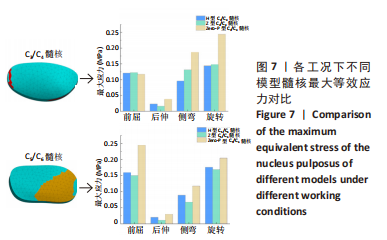
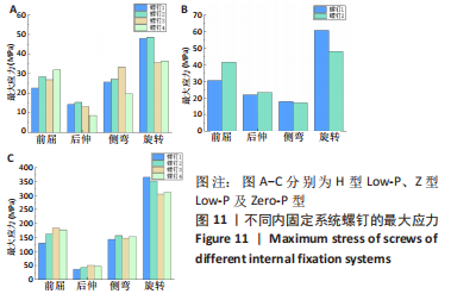
2.7 螺钉最大应力对比 将颈椎的C4-C5病变锥体采用H型Low-P、Z型Low-P、Zero-P型内固定系统固定后,对颈椎模型施加1.5 N·m载荷。在4种工况下,螺钉的最大应力见图11所示。Zero-P型螺钉应力均大于H型与Z型螺钉应力,H型与Z型螺钉应力比较接近。结果表明,H型螺钉在旋转工况下螺钉2的应力值最大,应力值为48.686 MPa;Z型螺钉在旋转工况下螺钉1的应力值最大,应力值为60.672 MPa;Zero-P型螺钉在旋转工况下螺钉1的应力值最大,应力值为355.21 MPa。Zero-P型螺钉最大应力为H型的7.5倍,为Z型的6倍。Zero-P型螺钉断裂概率比Z型Low-P与H型Low-P大。"
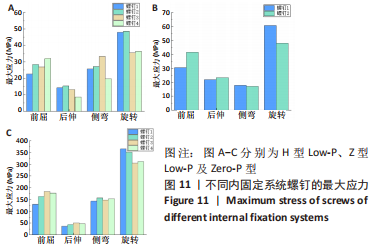
| [1] 贾连顺,陈雄生.颈椎病前路融合与非融合手术治疗的历史观[J].脊柱外科杂志,2022,20(3):145-148. [2] 王立公,常双超.广州市中青年不同人群颈椎病发病率的调查研究[J].中国疗养医学,2010,19(5):473-474. [3] PATHAK AK, AWASTHI HH, PANDEY AK. Use of Dashamoola in Cervical Spondylosis: Past and Present Perspective. JoAYUSH. 2015;4(1):10-16. [4] KAISER MG, HAID RW JR, SUBACH BR, et al. Anterior cervical plating enhances arthrodesis after discectomy and fusion with cortical allograft. Neurosurgery. 2002;50(2):229-236. [5] SONG KJ, TAGHAVI CE, LEE KB, et al. The efficacy of plate construct augmentation versus cage alone in anterior cervical fusion. Spine (Phila Pa 1976). 2009;34(26):2886-2892. [6] KANDZIORA F, SCHNAKE KJ, HOFFMANN R, et al. A new zeroprofile implant for stand-alone anterior cervical interbody fusion. Clin Orthop Relat Res. 2011;469(3):666-673. [7] FOUNTAS KN, KAPSALAKI EZ, NIKOLAKAKOS LG, et al. Anterior cervical discect to my and fusion associated complications. Spine (Phila Pa 1976). 2007;32(21):2310-2317. [8] LEE YS, KIM YB, PARK SW. Does a zero-profile anchored cage offer additional stabilization as anterior cervical plate. Spine. 2015;40(10) : E563-E570. [9] LEE YS, KIM YB, PARK SW. Risk factors for postoperative subsidence of single-level anterior cervical discectomy and fusion: The significance of the preoperative cervical alignment. Spine. 2014;39(16):1280-1287. [10] 原芳,薛清华,刘伟强.有限元法在脊柱生物力学应用中的新进展[J].医用生物力学,2013,28(5):585-590. [11] 黄嘉华,林峰,姚天平.应用有限元检测植入器械的可行性分析[J].医用生物力学,2014,29(1):1-6. [12] 原芳,薛清华,刘伟强.有限元法在脊柱生物力学应用中的新进展[J].医用生物力学,2013,28(5):585-590. [13] 李宝强,于泽,徐志浩,等.颈椎前路单节段减压融合与减压融合联合钢板内固定对相邻节段生物力学效应的有限元分析[J].中国医学工程,2022,30(10):5-17. [14] LEE MJ, BAZAZ R, FUREY CG, et al. Influence of anterior cervical plate design on Dysphagia: a 2-year prospective longitudinal follow-up study. J Spinal Disorders Tech. 2005;18(5):406-409. [15] 李龙文. 基于有限元法人体颈椎生物力学分析[D]. 哈尔滨: 哈尔滨理工大学,2015. [16] 赵齐通. Cage-Plate 颈椎内固定器与两种零切迹固定器的生物力学研究[D]. 上海: 上海交通大学,2018. [17] GOEL VK, CLAUSEN JD. Prediction of load sharing among spinal components of a C5-C6 motion segment using the finite element approach. Spine. 1998;23(6):684-691. [18] KUMARESAN S, YOGANANDAN N, PINTAR FA. Finite element modeling of spinal ligaments. Am Soc Mech Eng. 1999;42:281-282. [19] WHEELDON JA, PINTAR FA, KNOWLES S, et al. Experimental flexion/extension data corridors for validation of finite element models of the young, normal cervical spine. J Biomech. 2006;39(2):375-380. [20] KUMARESAN S, YOGANANDAN N, PINTAR FA. Nonlinear finite element analysis of human cervical spine facet joint. Am Soc Mech Eng. 1997; 35:447-448. [21] 姜广崇,李学峰,聂林,等.利用 Mimics 和 Abaqus 建立正 常人颈椎的三维有限元模型[J]. 中国矫形外科杂志,2013,21(11):1114-1120. [22] TEO E, NG H. Evaluation of the role of ligaments, facets and disc nucleus in lower cervical spine under compression and sagittal moments using finite element method. Med Eng Phys. 2001;23(3):155-164. [23] KUMARESAN S, YOGANANDAN N, PINTAR F. Finite element modeling approaches of human cervical spine facet joint capsule. J Biomech. 1998;31(4):371-376. [24] YOGANANDAN N, KUMARESAN S, PINTARF A. Biomechanics of the cervical spine. Part 2. Cervical spine soft tissue responses and biomechanical modeling. Clin Biomech. 2001;16(1):1-27. [25] PANJABI MM. Cervical spine models for biomechanical research. Spine. 1998;23(24):2684-2700. [26] RONG X, WANG B, DING C, et al. The biomechanical impact of the facet tropism on the intervertebral disc and facet joints in the cervical spine. Spine J. 2017;17(12):1926-1931. [27] PANJABI MM, CRISCO JJ, VASAVADA A, et al. Mechanical properties of the human cervical spine as shown by three-dimensional load-displacement curves. Spine. 2001;26(24):2692-2700. [28] ZHANG QH, TEO EC, NG HW, et al. Finite element analysis of momentrotation relationships for human cervical spine. J Biomech. 2006;39(1):189-193. [29] 罗俊普,何永志,林斌,等.颈前路减压cage与zero-p椎间植骨融合内固定治疗单节段颈椎病的疗效比较[J].中国骨与关节损伤杂志,2021,36(9):897-900. [30] 李鹏飞,危国军,石作为,等.颈前路应用Zero-P椎间融合系统与钛板联合cage融合系统治疗颈椎病的Meta分析[J].中国脊柱脊髓杂志,2019,29(3):235-246. [31] 许艺荠,张雪松,孙太存,等.新型Zero-P与cage钛板椎间融合器修复颈椎病:早期稳定性对比[J].中国组织工程研究,2016,20(22): 3227-3234. |
| [1] | Kang Zhijie, Cao Zhenhua, Xu Yangyang, Zhang Yunfeng, Jin Feng, Su Baoke, Wang Lidong, Tong Ling, Liu Qinghua, Fang Yuan, Sha Lirong, Liang Liang, Li Mengmeng, Du Yifei, Lin Lin, Wang Haiyan, Li Xiaohe, Li Zhijun. Finite element model establishment and stress analysis of lumbar-sacral intervertebral disc in ankylosing spondylitis [J]. Chinese Journal of Tissue Engineering Research, 2024, 28(6): 840-846. |
| [2] | Zhang Min, Peng Jing, Zhang Qiang, Chen Dewang. Mechanical properties of L3/4 laminar decompression and intervertebral fusion in elderly osteoporosis patients analyzed by finite element method [J]. Chinese Journal of Tissue Engineering Research, 2024, 28(6): 847-851. |
| [3] | Xue Xiaofeng, Wei Yongkang, Qiao Xiaohong, Du Yuyong, Niu Jianjun, Ren Lixin, Yang Huifeng, Zhang Zhimin, Guo Yuan, Chen Weiyi. Finite element analysis of osteoporosis in proximal femur after cannulated screw fixation for femoral neck fracture [J]. Chinese Journal of Tissue Engineering Research, 2024, 28(6): 862-867. |
| [4] | Huang Peizhen, Dong Hang, Cai Qunbin, Lin Ziling, Huang Feng. Finite element analysis of anterograde and retrograde intramedullary nail for different areas of femoral shaft fractures [J]. Chinese Journal of Tissue Engineering Research, 2024, 28(6): 868-872. |
| [5] | Wang Mingming, Zhang Zhong, Sun Jianhua, Zhao Gang, Song Hua, Yan Huadong, Lyu Bin. Finite element analysis of three different minimally invasive fixation methods for distal tibial fractures with soft tissue injury [J]. Chinese Journal of Tissue Engineering Research, 2024, 28(6): 879-885. |
| [6] | Hou Zexin, Xu Benke, Dai Yuan, He Chuan, Zhang Chaoju, Li Xiaolin. Finite element analysis of the mechanism of dorsiflexion injury of wrist joint in elderly people after falls [J]. Chinese Journal of Tissue Engineering Research, 2024, 28(6): 886-890. |
| [7] | Ning Tianliang, Wang Kun, Wang Lingbiao, Han Pengfei. Finite element analysis on correction effect of varus foot orthosis based on the three-point force principle [J]. Chinese Journal of Tissue Engineering Research, 2024, 28(6): 891-899. |
| [8] | Zhang Lili, Zhang Xinglai, Zhang Jie, Zheng Jiejiao. Effect of visual feedback on landing biomechanics in chronic ankle instability patients [J]. Chinese Journal of Tissue Engineering Research, 2024, 28(6): 900-904. |
| [9] | Wei Yuanbiao, Lin Zhan, Chen Yanmei, Yang Tenghui, Zhao Xiao, Chen Yangsheng, Zhou Yanhui, Yang Minchao, Huang Feiqi. Finite element analysis of effects of sagittal cervical manipulation on intervertebral disc and facet joints [J]. Chinese Journal of Tissue Engineering Research, 2024, 28(6): 827-832. |
| [10] | Zhang Rui, Wang Kun, Shen Zicong, Mao Lu, Wu Xiaotao. Effects of endoscopic foraminoplasty and laminoplasty on biomechanical properties of intervertebral disc and isthmus [J]. Chinese Journal of Tissue Engineering Research, 2024, 28(6): 833-839. |
| [11] | Zhang Qianlong, Maihemuti•Yakufu, Song Chenhui, Liu Xiuxin, Ren Zheng, Liu Yuzhe, Muyashaer•Abudushalamu, Sajidan•Aikebaier, Ran Jian. Finite element analysis of the effect of the distribution position and content of bone cement on the stress and displacement of reverse femoral intertrochanteric fracture [J]. Chinese Journal of Tissue Engineering Research, 2024, 28(3): 336-340. |
| [12] | Chen Yuanyuan, Wang Wei, Zhao Lu, Annikaer·Aniwaer, Nijati·Turson. Finite element analysis of the influence of scaffold materials on the fixed restoration of edentulous maxillary implants under two designs [J]. Chinese Journal of Tissue Engineering Research, 2024, 28(3): 411-418. |
| [13] | Zhang Guorui, Zhang Kunwu, Chen Wenyuanfeng, Liu Yining, Li Duhong, Zhang Xinzhu, Cao Baocheng. Effect of different stretching lengths of lingual movable wing on the adduction of mandibular anterior teeth: a biomechanical study [J]. Chinese Journal of Tissue Engineering Research, 2024, 28(2): 247-251. |
| [14] | Zhong Yizheng, Huang Peizhen, Cai Qunbin, Zheng Liqin, He Xingpeng, Dong Hang. Microstructural indexes that determine the trabecular bone maximum stress of micro-finite element models [J]. Chinese Journal of Tissue Engineering Research, 2023, 27(9): 1313-1318. |
| [15] | Wu Taoguang, Nie Shaobo, Chen Hua, Zhu Zhengguo, Qi Lin, Tang Peifu. Biomechanical characteristics of a new multi-dimensional cross locking plate in the treatment of subtrochanteric nonunion [J]. Chinese Journal of Tissue Engineering Research, 2023, 27(9): 1330-1334. |
| Viewed | ||||||
|
Full text |
|
|||||
|
Abstract |
|
|||||

